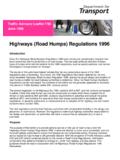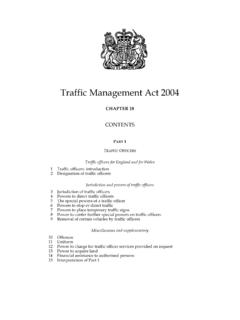Transcription of The case for rail transportation of hazardous materials
1 Journal of Management and Marketing Research The Case for rail , Page 1 The case for rail transportation of hazardous materials H. Barry Spraggins University of Nevada, Reno ABSTRACT Safe transportation of hazardous materials in the United States is an important national issue. Given the dimension of terrorism, the movement of hazardous materials encompasses an even greater safety concern. The great majority of these materials move by either rail or truck. With an ever increasing number of trucks moving on the nation s highways, there is cause for concern not only over safety issues, but the impact on highway gridlock, environmental implications, and infrastructure deterioration. Rails can offer many advantages over truck for hazardous materials movement. This paper delineates the advantages of rail movements of hazardous materials . The recent advances in rail safety technology to help reduce risk are noted. Finally, the issues and challenges revolving around shifting hazardous materials movements from truck to rail are explored.
2 Keywords: rail /Truck hazardous materials movement, rail Accidents, Hazmat transportation Journal of Management and Marketing Research The Case for rail , Page 2 INTRODUCTION Valid concern is growing over deterioration and damage of the nation s highways and bridges caused by the ever-increasing truck traffic. There is simply not enough highway capacity to handle the significant numbers of new trucks, nor is it possible to plan and build sufficient highways to prevent further deterioration of capacity. Given ever increasing highway congestion, the Department of transportation (DOT) has predicted that freight railroad demand will rise 88 percent by 2035 (Railroads, 2009). Railroads will take on an increasing responsibility for movement of the nation s goods including hazardous materials . Transporting hazardous materials is crucial to the nation s viability. rail PERVASIVENESS AND ADVANTAGES Railroads are vital to the national defense, economy, and public health.
3 They provide critical support to the Department of Defense Strategic rail Corridor Network which includes more than 30,000 miles of rail line for the movement of Department of Defense shipments. Some 40 % of all intercity freight goes by rail , including 67% of the coal or million carloads used by electric utilities to produce power. They move 70 percent of new autos including million carloads of vehicles, parts and accessories. Rails move million carloads of lumber and paper products. Intermodal traffic has been the fastest growing rail traffic segment over the past 20 years and is now the largest single traffic segment for rail . Intermodal grew from 3 million trailers and containers to around 12 million today. Approximately 60 percent of this traffic consists of imports and exports from and to international ports (Railroads( 2009). Freight railroads significantly reduce highway congestion. One intermodal train can haul around 280 trucks.)
4 A train moving other types of freight can move up 500 truckload equivalents. They are cost-effective and lessen the impact on the highway system as the figures below depict (Safety (2008). Rails also have a major safety advantage. rail freight transportation incurs about 12 percent of the fatalities and 6 percent of the injuries that trucks do per trillion ton-miles. The employee injury rate is about half of truck (Economic, 2009). Specifically, the number of large truck accidents was 367,920 in 2006 vs. 2,962 for rail ; less than one percent of truck (Freight Facts (2008). Railroads have reduced their overall train accident rate 71 percent from 1980 to 2007 and 15 percent since 1990. The rate of employee casualties has been reduced 80 percent since 1980. The grade crossing collision rate which has fallen every year since 1978 fell 77 percent from 1980 to 2007. This is a considerable feat given there are approximately 227,000 grade crossings in the (Safety, 2008).))
5 Journal of Management and Marketing Research The Case for rail , Page 3 The following graphs depict the advances in rail safety. Figure 1 2008 Figure 2 2008 rail Accident & Injury Rates Injury Rates Per 200,000 Employee hours Journal of Management and Marketing Research The Case for rail , Page 4 Figure 3 2008 hazardous MATERIAL transportation BY rail VS TRUCK Twenty percent of the nation s chemicals move by rail . But railroads carry an even higher percentage of those chemicals essential to the public health and standard of living for the United States. Rails move 22 percent or 35,000 carloads annually of chlorine which is an essential element used to purify more than half the nation s water supplies and contained in 85 percent of all pharmaceuticals (Hazmat, 2009). Other hazardous materials (hazmats) moved by rail include fuels, fertilizers, disinfectants and cleaners, along with the chemicals used in foods, glass, medicines, weapons and munitions.
6 The transportation of hazmats is an important problem due to their pervasiveness. hazardous materials , or dangerous goods, include explosives, gases, flammable liquids and solids, oxidizing substances, poisonous and infectious substances, radioactive materials , corrosive substances, and hazardous wastes. Due to the nature of most chemicals, they can pose hazards of explosion, toxic release, and fire. The approximate million carloads of hazmat transported by rail each year present a Toxic Inhalation Hazard (TIH). These are gases or liquids such as chlorine and anhydrous ammonia that are especially dangerous if released (Hazmat, 2009). The fact that the volume of hazardous materials moving by rail more than doubled since 1980 indicates that rail has become an integral part of the tremendous increase in the transport of hazardous materials . Because rail and truck transportation is inherently interstate in nature, the safe transport of any commodity, including hazardous materials , requires uniform standards that apply nationally.
7 As common carriers, railroads and most major trucking firms are required by federal law to move hazardous materials . Since both modes must transport hazardous materials , the focus should be on the safest method of shipping, rail . Grade Crossing Collision Per Million Train-Miles Journal of Management and Marketing Research The Case for rail , Page 5 Railroads have an outstanding track record in safely delivering hazardous materials -- percent of all rail cars containing hazardous materials arrived at destination safely, without any release due to an accident. In fact, the rail hazmat accident rate has declined by 88 percent from 1980 to 2007 and 39 percent since 1990. Railroads and trucks carry roughly equal hazmat ton-mileage, but trucks have 16 times more hazmat releases than railroads (Hazmat, nd). Statistically, railroads are the safer form of transportation for hazardous materials . Figure 4 - Truck vs. Railroad Hazmat Incidents: 1980 - 2007 Source: DOT- Pipeline and hazardous materials Safety Administration -2008 RISK OF HAZMAT MODAL ROUTING What differentiates shipments of hazmats from shipments of other materials is the risk associated with a release of these materials during transportation .
8 Hazmats can be extremely harmful to the environment and to human health since exposure to their toxic chemical ingredients could lead to the injury or death of humans, plants, and animals. While toxic inhalation chemicals ( chlorine) account for only percent of all rail carloads, they constitute the largest risk costs for freight railroads (Current rail Hazmat (2006). To carry out routing mode and risk assessment of hazardous substances during transportation , one must consider the complexity and magnitude of chemicals moving through the transportation network. The multiplicity of chemical and physical characteristics of substances, location of manufacturing facility in relation to final destination and volume of cargo tend to further enhance the dimensions and complicate the issue. Routing hazmat shipments by rail has proven to have the definitive advantage over truck (Hazmat Facts (2009). ADVANCES IN rail SAFETY TO REDUCE RISK Rails have made great strides in improved safety during the past decade.))
9 Some of the many technological advances by the rails that have increased safety include Current rail Hazmat et al. ( 2006). Journal of Management and Marketing Research The Case for rail , Page 6 Wayside detectors-machine vision Wheel profile monitors- laser and optic Acoustic detectors-acoustic signatures Track geometry cars-electronic and optical Improved metallurgy-track geometry rail defect cars-internal flaws Advanced track grinding-reduce rail fatigue Ground penetrating radar and terrain conductivity sensors-problems below ground Improved track lubrication techniques-extend rail life and reduce fuel costs Electronically controlled pneumatic brakes-even braking action for the entire train Global positioning systems-huge variety of applications. DISCUSSION The issues revolving around hazardous materials transport by truck or rail are many and varied. The required hurtles to resolve many of the issues are enormous.
10 One issue is the transport of large quantities of chemicals listed as toxic by inhalation through major cities. Leaving aside whether transferring risk from one group of citizens to another is acceptable public policy, there are serious safety issues associated with routing decisions. Safety can be compromised as exposure increases. For example, rerouting can involve an increase in miles traveled, and those additional miles could be on infrastructure less suitable for a variety of reasons to handling hazardous materials . Emergency response capability along alternate routes may often lack requisite expertise in handling the most dangerous commodities. Shifting more hazardous materials from truck to rail is a challenge that requires the rail industry become more competitive and willing to accept their common carrier obligations given the unique requirements of hazmat movement. Lack of good data on truck hazmat movement is a particular challenge.















